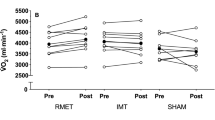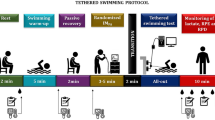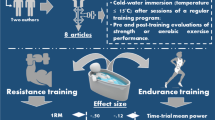Abstract
The efficiency of the respiratory system presents significant limitations on the body’s ability to perform exercise due to the effects of the increased work of breathing, respiratory muscle fatigue, and dyspnoea. Respiratory muscle training is an intervention that may be able to address these limitations, but the impact of respiratory muscle training on exercise performance remains controversial. Therefore, in this study we evaluated the effects of a 12-week (10 sessions week−1) concurrent inspiratory and expiratory muscle training (CRMT) program in 34 adolescent competitive swimmers. The CRMT program consisted of 6 weeks during which the experimental group (E, n=17) performed CRMT and the sham group (S, n=17) performed sham CRMT, followed by 6 weeks when the E and S groups performed CRMT of differing intensities. CRMT training resulted in a significant improvement in forced inspiratory volume in 1 s (FIV1.0) (P=0.050) and forced expiratory volume in 1 s (FEV1.0) (P=0.045) in the E group, which exceeded the S group’s results. Significant improvements in pulmonary function, breathing power, and chemoreflex ventilation threshold were observed in both groups, and there was a trend toward an improvement in swimming critical speed after 12 weeks of training (P=0.08). We concluded that although swim training results in attenuation of the ventilatory response to hypercapnia and in improvements in pulmonary function and sustainable breathing power, supplemental respiratory muscle training has no additional effect except on dynamic pulmonary function variables.





Similar content being viewed by others
References
Aaron EA, Seow KC, Johnson BD, Dempsey JA (1992) Oxygen cost of exercise hyperpnea, implications for performance. J Appl Physiol 72:1818–1825
Altose M, Cherniack N, Fishman AP (1985) Respiratory sensations and dyspnea. J Appl Physiol 58:1051–1054
American Thoracic Society Standardization of Spirometry (1995) 1994 Update. Am J Respir Crit Care Med 152:1107–1136
Blum J, Kanarek D, Callahan B (1979) The effect of training on CO2 responsiveness in normal subjects. Am Rev Resp Dis 119:291–294
Boutellier U (1998) Respiratory muscle fitness and exercise endurance in healthy humans. Med Sci Sports Exerc 30:1169–1172
Boutellier U, Piwko P (1992) The respiratory system as an exercise limiting factor in normal sedentary subjects. Eur J Appl Physiol 64:145–152
Boutellier U, Buchel R, Kundert A, Spengler C (1992) The respiratory system as an exercise limiting factor in normal trained subjects. Eur J Appl Physiol Occup Physiol 65:347–353
Clanton TL, Dixon GF, Drake J, Gadek JE (1985) Effects of breathing pattern on inspiratory muscle endurance in humans. J Appl Physiol 59:1834–1841
Clanton TL, Dixon GF, Drake J, Gadek JE (1987) Effects of swim training on lung volumes and inspiratory muscle conditioning. J Appl Physiol 62:39–46
Courteix D, Obert P, Lecoq AM, Guenon P, Koch G (1997) Effect of intensive swimming training on lung volumes, airway resistance and on the maximal expiratory flow-volume relationship in prepubertal girls. Eur J Appl Physiol Occup Physiol 76:264–269
Derchak PA, Sheel AW, Morgan BJ, Dempsey JA (2002) Effects of expiratory muscle work on muscle sympathetic nerve activity. J Appl Physiol 92:1539–1552
Dicker SG, Lofthus GK, Thornton NW, Brooks GA (1980) Respiratory and heart rate responses to tethered controlled frequency breathing swimming. Med Sci Sports Exerc 12:20–23
Duffin J, Mohan RM, Vasiliou P, Stephenson R, Mahamed S (2000) A model of the chemoreflex control of breathing in humans, model parameters measurement. Respir Physiol 120:13–26
Dutton K, Blanksby BA, Morton AR (1989) CO2 sensitivity changes during the menstrual cycle. J Appl Physiol 67:517–522
Eastwood PR, Hillman DR, Finucane KE (2001) Inspiratory muscle performance in endurance athletes and sedentary subjects. Respirology 6(2):95–104
Fairbarn MS, Coutts KC, Pardy RL, McKenzie DC (1991) Improved respiratory muscle endurance of highly trained cyclists and the effects on maximal exercise performance. Int J Sports Med 12:66–70
Fanta CH, Leith DE, Brown R (1983) Maximal shortening of inspiratory muscles: effect of training. J Appl Physiol 54:1618–1623
Farkas GA, Cerny FJ, Rochester DF (1996) Contractility of the ventilatory pump muscles. Med Sci Sports Exerc 28(9):1106–1114
Godfrey S, Edwards R, Copland G, Gross P (1971) Chemosensitivity in normal subjects, athletes, and patients with chronic airway obstruction. J Appl Physiol 30:193–199
Harms CA, Wetter TJ, St Croix CM, Pegelow DF, Dempsey JA (2000) Effects of respiratory muscle work on exercise performance. J Appl Physiol 89:131–138
Heigenhauser GJ, Oldridge NB, Jones NL (1983) The CO2 responsiveness and ventilatory response to leg and arm exercise in female swimmers. Respir Physiol 53:263–272
Hong SK, Cerretelli P, Cruz JC, Rahn H (1969) Mechanics of respiration during submersion in water. J Appl Physiol 27:535–538
Hsieh SS, Hermiston RT (1983) The acute effects of controlled breathing swimming on glycolytic parameters. Can J Appl Sport Sci 8:149–154
Inbar O, Weiner P, Azgad Y, Rotstein A, Weinstein Y (2000) Specific inspiratory muscle training in well-trained endurance athletes. Med Sci Sports Exerc 32:1233–1237
Katayama K, Sato Y, Morotome Y, Shima N, Ishida K, Mori S et al (1999) Ventilatory chemosensitive adaptations to intermittent hypoxic exposure with endurance training and detraining. J Appl Physiol 86:1805–1811
Kohl J, Koller EA, Brandenberger M, Cardenas M, Boutellier U (1997) Effect of exercise-induced hyperventilation on airway resistance and cycling endurance. Eur J Appl Physiol 75:305–311
Leith DE, Bradley M (1976) Ventilatory muscle strength and endurance training. J Appl Physiol 41:508–516
Loke J, Mahler DA, Virgulto JA (1982) Respiratory muscle fatigue after marathon running. J Appl Physiol 52(4):821–824
Lomax ME, McConnell AK (2003) Inspiratory muscle fatigue in swimmers after a single 200 m swim. J Sports Sci 21:659–664
Mahamed S, Ali AF, Ho D, Wang B, Duffin J (2001) The contribution of chemoreflex drives to resting breathing in man. Exp Physiol 86:109–116
Mahler DA, Moritz ED, Loke J (1982) Ventilatory responses at rest and during exercise in marathon runners. J Appl Physiol 52:388–392
Markov G, Orler R, Boutellier U (1996) Respiratory training, hypoxic ventilatory response and acute mountain sickness. Respir Physiol 105:179–186
Markov G, Spengler CM, Knopfli-Lenzin C, Stuessi C, Boutellier U (2001) Respiratory muscle training increases cycling endurance without affecting cardiovascular responses to exercise. Eur J Appl Physiol 85:233–239
Mateika JH, Duffin J (1995) A review of the control of breathing during exercise. Eur J Appl Physiol 71:1–27
McMahon ME, Boutellier U, Smith RM, Spengler CM (2002) Hyperpnea training attenuates peripheral chemosensitivity and improves cycling endurance. J Exp Biol 205:3937–3943
Metzger JM, Fitts RH (1986) Contractile and biochemical properties of diaphragm: effects of exercise training and fatigue. J Appl Physiol 60(5):1752–1758
Miyamura M, Yamashina T, Honda Y (1976) Ventilatory responses to CO2 rebreathing at rest and during exercise in untrained subjects and athletes. Jpn J Physiol 26:245–254
Mohan R, Duffin J (1997) The effect of hypoxia on the ventilatory response to carbon dioxide in man. Respir Physiol 108:101–115
Morgan DW, Kohrt WM, Bates BJ, Skinner JS (1987) Effects of respiratory muscle endurance training on ventilatory and endurance performance of moderately trained cyclists. Int J Sports Med 8:88–93
Nickerson BG, Keens TG (1982) Measuring ventilatory muscle endurance in humans as sustainable inspiratory pressure. J Appl Physiol 52(3):768–772
Noakes TD (2000) Physiological models to understand exercise fatigue and the adaptations that predict or enhance athletic performance. Scand J Med Sci Sports 10(3):123–145
O’Kroy JA, Coast JR (1993) Effects of flow and resistive training on respiratory muscle endurance and strength. Respiration 60:279–283
Pyne DB, Lee H, Swanwick KM (2001) Monitoring the lactate threshold in world-ranked swimmers. Med Sci Sports Exerc 33:291–297
Read DJC (1967) A clinical method for assessing the ventilatory response to CO2. Austral Ann Med 16:20–32
Romer LM, McConnell AK, Jones DA (2002) Effects of inspiratory muscle training on time-trial performance in trained cyclists. J Sports Sci 20:547–562
Sale DG (1988) Neural adaptation to resistance training. Med Sci Sports Exerc 20:S135–S145
Sheel AW (2002) Respiratory muscle training in healthy individuals—physiological rationale and implications of exercise performance. Sports Med 32:567–581
Sheel AW, Derchak PA, Morgan BJ, Pegelow DF, Jacques AJ, Dempsey JA (2001) Fatiguing inspiratory muscle work causes reflex reduction in resting leg blood flow in humans. J Physiol 537:277–289
Sonetti DA, Wetter TJ, Pegelow DF, Dempsey JA (2001) Effects of respiratory muscle training versus placebo on endurance exercise performance. Respir Physiol 127:185–199
Spengler CM, Roos M, Laube SM, Boutellier U (1999) Decreased exercise blood lactate concentrations after respiratory endurance training in humans. Eur J Appl Physiol 79:299–305
St Croix CM, Morgan BJ, Wetter TJ, Dempsey JA (2000) Fatiguing inspiratory muscle work causes reflex sympathetic activation in humans. J Physiol 529:493–504
Stuessi C, Spengler CM, Knopfli-Lenzin C, Markov G, Boutellier U (2001) Respiratory muscle endurance training in humans increases cycling endurance without affecting blood gas concentrations. Eur J Appl Physiol 84:582–586
Thomas JR, von Gunten CF (2002) Clinical management of dyspnoea. Lancet Oncol 3:223–228
Town GP, Vanness JM (1990) Metabolic responses to controlled frequency breathing in competitive swimmers. Med Sci Sports Exerc 22:112–116
Treffene RJ (1978) Swimming Performance Test A method of training and performance time selection. Austr J Sports Med April/May/June:33–38
Walsh ML (2000) Whole body fatigue and critical power, a physiological interpretation. Sports Med 29:153–166
Weiner P, Magadle R, Beckerman M, Weiner M, Berar-Yanay N (2003) Comparison of specific expiratory, inspiratory, and combined muscle training programs in COPD. Chest 124:1357–1364
West JB (2000) Respiratory physiology—the essentials. Lippincott Williams and Williams, Baltimore
Williams JS, Wongsathikun J, Boon SM, Acevedo EO (2002) Inspiratory muscle training fails to improve endurance capacity in athletes. Med Sci Sports Exerc 34:1194–1198
Zwillich CW, Natalino MR, Sutton FD, Weil JV (1978) Effects of progesterone on chemosensitivity in normal men. J Lab Clin Med 92:262–269
Acknowledgements
We would like to thank the members of the Respiratory Research Group in the Department of Physiology at the University of Toronto for their helpful comments, and C. Goia at The Hospital for Sick Children, Toronto, for her help with the statistical analysis. We are grateful for the funding provided by the Ontario Thoracic Society. G. Wells was supported in part by the Petro-Canada Olympic Torch Scholarship and the University of Toronto Open Fellowship. We would also like to thank the following swim clubs for their participation: Toronto, North York, Mississauga, Milton, and Oakville. We also thank Adidas Solomon Canada Inc. for their donation of swimming equipment, Polar Inc. for assistance with the heart rate monitors, and PowerLung Inc. for donating the PowerLung training devices that the athletes used in this study. B. Bauer provided valuable editorial comments.
Author information
Authors and Affiliations
Corresponding author
Rights and permissions
About this article
Cite this article
Wells, G.D., Plyley, M., Thomas, S. et al. Effects of concurrent inspiratory and expiratory muscle training on respiratory and exercise performance in competitive swimmers. Eur J Appl Physiol 94, 527–540 (2005). https://doi.org/10.1007/s00421-005-1375-7
Accepted:
Published:
Issue Date:
DOI: https://doi.org/10.1007/s00421-005-1375-7




